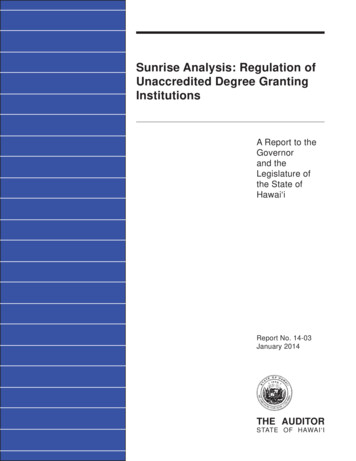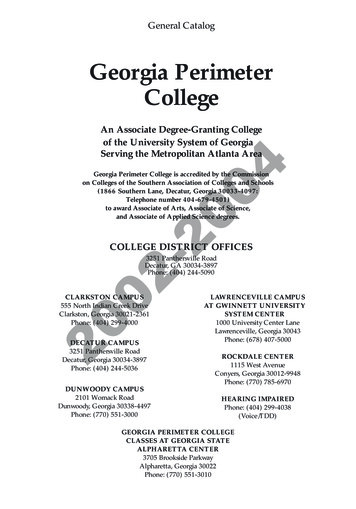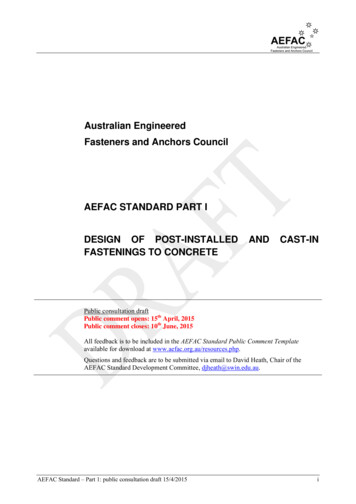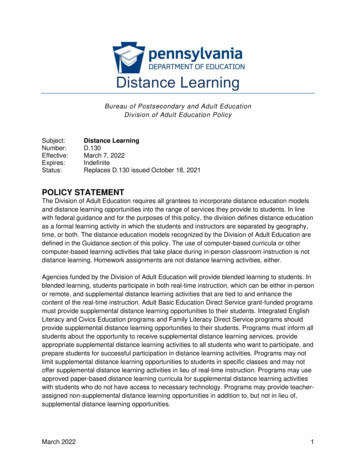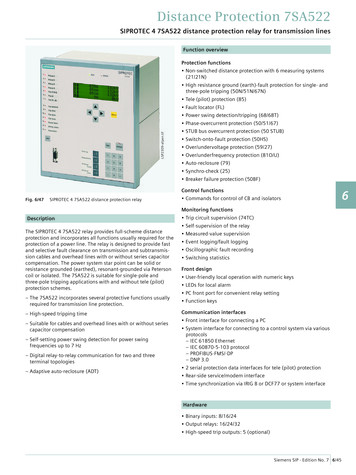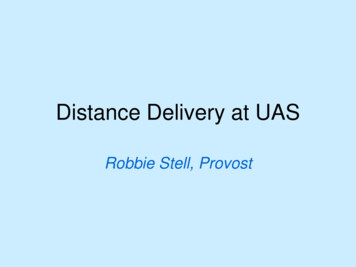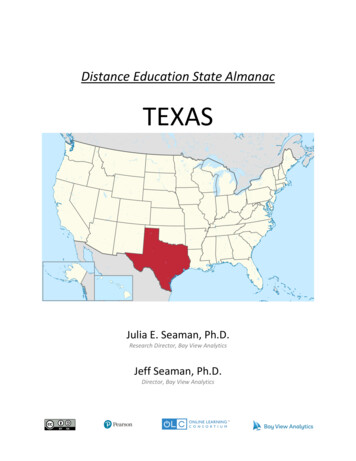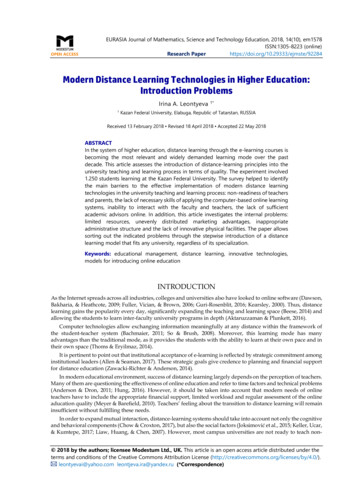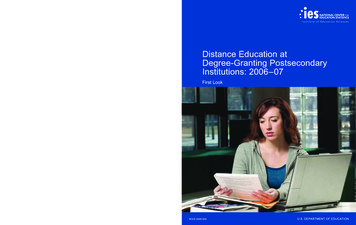
Transcription
Distance Education at Degree-Granting Postsecondary Institutions: 2006–07www.ed.govDistance Education atDegree-Granting PostsecondaryInstitutions: 2006–07First Lookies.ed.gov2008NCES 2009-044U.S. DEPARTMENT OF EDUCATION
Distance Education atDegree-Granting PostsecondaryInstitutions: 2006–07First LookDecember 2008Basmat ParsadLaurie LewisWestatPeter TiceProject OfficerNational Center for Education StatisticsNCES 2009–044U.S. DEPARTMENT OF EDUCATION
U.S. Department of EducationMargaret SpellingsSecretaryInstitute of Education SciencesSue BetkaActing DirectorNational Center for Education StatisticsStuart KerachskyActing CommissionerThe National Center for Education Statistics (NCES) is the primary federal entity for collecting, analyzing,and reporting data related to education in the United States and other nations. It fulfills a congressionalmandate to collect, collate, analyze, and report full and complete statistics on the condition of education inthe United States; conduct and publish reports and specialized analyses of the meaning and significance ofsuch statistics; assist state and local education agencies in improving their statistical systems; and review andreport on education activities in foreign countries.NCES activities are designed to address high-priority education data needs; provide consistent, reliable,complete, and accurate indicators of education status and trends; and report timely, useful, and high-qualitydata to the U.S. Department of Education, the Congress, the states, other education policymakers,practitioners, data users, and the general public. Unless specifically noted, all information contained herein isin the public domain.We strive to make our products available in a variety of formats and in language that is appropriate to avariety of audiences. You, as our customer, are the best judge of our success in communicating informationeffectively. If you have any comments or suggestions about this or any other NCES product or report, wewould like to hear from you. Please direct your comments toNational Center for Education StatisticsInstitute of Education SciencesU.S. Department of Education1990 K Street NWWashington, DC 20006-5651December 2008The NCES World Wide Web Home Page address is http://nces.ed.gov.The NCES World Wide Web Electronic Catalog is http://nces.ed.gov/pubsearch.Suggested CitationParsad, B., and Lewis, L. (2008). Distance Education at Degree-Granting Postsecondary Institutions: 2006–07 (NCES2009–044). National Center for Education Statistics, Institute of Education Sciences, U.S. Department ofEducation. Washington, DC.For ordering information on this report, write toU.S. Department of EducationED PubsP.O. Box 1398Jessup, MD 20794-1398or call toll free 1-877-4ED-Pubs or order online at http://www.edpubs.org.Content ContactPeter Tice(202) 502-7497peter.tice@ed.gov
AcknowledgmentsThe authors would like to recognize the respondents from postsecondary institutions who provideddata on distance education upon which the report is based. We also thank the sponsors from the Office ofEducational Technology.iii
This page intentionally left blank.
ContentsPageAcknowledgments .iiiList of Tables .viAppendix A Tables .viiiFirst Look Summary . 1Introduction. 1Selected Findings . 2Tables. 5References. 19Appendix A: Standard Error Tables .A-1Appendix B: Technical Notes. B-1Appendix C: Questionnaire . C-1v
List of TablesTable123456789PageTotal number of 2-year and 4-year Title IV degree-granting postsecondaryinstitutions, and percent that offered distance education courses, by course type,institutional type, and institution size: 2006–07.5Percent of 2-year and 4-year Title IV degree-granting postsecondary institutionsoffering online, hybrid/blended online, and other types of college-level creditgranting distance education courses, by course type, institutional type, andinstitution size: 2006–07 .6Percentage distribution of 2-year and 4-year Title IV degree-grantingpostsecondary institutions offering distance education that reported the minimumamount of online instruction or other criteria required to formally designate coursesas online, by institutional type and institution size: 2006–07 .7Total number of enrollments in college-level credit-granting distance educationcourses at 2-year and 4-year Title IV degree-granting postsecondary institutions,by course type, institutional type, and institution size: 2006–07 .8Total enrollments in online, hybrid/blended online, and other types of college-levelcredit-granting distance education courses at 2-year and 4-year Title IV degreegranting postsecondary institutions, and percent of total distance educationenrollments, by course level, institutional type, and institution size: 2006–07 .9Percent of all 2-year and 4-year Title IV degree-granting postsecondary institutionsoffering any college-level credit-granting distance education courses, and percentthat had college-level degree or certificate programs designed to be completedtotally through distance education, by program level, institutional type, andinstitution size: 2006–07 .10Total number of college-level degree or certificate programs designed to becompleted totally through distance education at 2-year and 4-year Title IV degreegranting postsecondary institutions, and percent of total distance educationprograms, by program type, program level, institutional type, and institution size:2006–07 .11Percent of 2-year and 4-year Title IV degree-granting postsecondary institutionsoffering any academic distance education courses for elementary or secondarystudents, by course type, institutional type, and institution size: 2006–07 .12Percentage distribution of 2-year and 4-year Title IV degree-grantingpostsecondary institutions that offered distance education reporting frequency ofrequests for accommodations for students with disabilities in distance educationcourses over the last 3 years, by institutional type and institution size: 2006–07.13vi
List of Tables (Continued)TablePage10 Percentage distribution of 2-year and 4-year Title IV degree-grantingpostsecondary institutions offering any distance education courses reporting use ofvarious technologies or media for instruction in college-level credit-grantingdistance education courses: 2006–07.1411 Percent of 2-year and 4-year Title IV degree-granting postsecondary institutionsoffering any distance education courses reporting that they used varioustechnologies or mediums to a moderate or large extent for instructional delivery ofcollege-level credit-granting distance education courses, by institutional type andinstitution size: 2006–07 .1512 Percentage distribution of 2-year and 4-year Title IV degree-grantingpostsecondary institutions offering any distance education courses reporting theextent to which various factors affected decisions regarding distance educationofferings: 2006–07 .1613 Percent of 2-year and 4-year Title IV degree-granting postsecondary institutionsoffering any distance education courses reporting that various factors affecteddecisions regarding distance education offerings to a moderate or major extent,by institutional type and institution size: 2006–07 .1714 Percent of 2-year and 4-year Title IV degree-granting postsecondary institutionsindicating means for acquiring or developing distance education courses,by credit/noncredit courses, institutional type, and institution size: 2006–07 .18vii
Appendix A TablesTable1a2a3a4a5a6a7a8aPageStandard errors for the total number of 2-year and 4-year Title IV degree-grantingpostsecondary institutions, and percent that offered distance education courses,by course type, institutional type, and institution size: 2006–07 .A-3Standard errors for the percent of 2-year and 4-year Title IV degree-grantingpostsecondary institutions offering online, hybrid/blended online, and other typesof college-level credit-granting distance education courses, by course type,institutional type, and institution size: 2006–07.A-4Standard errors for the percentage distribution of 2-year and 4-year Title IVdegree-granting postsecondary institutions offering distance education thatreported the minimum amount of online instruction or other criteria required toformally designate courses as online, by institutional type and institution size:2006–07.A-5Standard errors for the total number of enrollments in college-level credit-grantingdistance education courses at 2-year and 4-year Title IV degree-grantingpostsecondary institutions, by course type, institutional type, and institution size:2006–07.A-6Standard errors for the total enrollments in online, hybrid/blended online, andother types of college-level credit-granting distance education courses at 2-yearand 4-year Title IV degree-granting postsecondary institutions, and percent oftotal distance education enrollments, by course level, institutional type, andinstitution size: 2006–07 .A-7Standard errors for the percent of all 2-year and 4-year Title IV degree-grantingpostsecondary institutions offering any college-level credit-granting distanceeducation courses, and percent that had college-level degree or certificateprograms designed to be completed totally through distance education,by program level, institutional type, and institution size: 2006–07 .A-8Standard errors for the total number of college-level degree or certificate programsdesigned to be completed totally through distance education at 2-year and 4-yearTitle IV degree-granting postsecondary institutions, and percent of total distanceeducation programs, by program type, program level, institutional type, andinstitution size: 2006–07 .A-9Standard errors for the percent of 2-year and 4-year Title IV degree-grantingpostsecondary institutions offering any academic distance education courses forelementary or secondary students, by course type, institutional type, andinstitution size: 2006–07 .A-10viii
Appendix A Tables (Continued)Table9aPageStandard errors for the percentage distribution of 2-year and 4-year Title IVdegree-granting postsecondary institutions that offered distance educationreporting frequency of requests for accommodations for students with disabilitiesin distance education courses over the last 3 years, by institutional type andinstitution size: 2006–07 .A-1110a Standard errors for the percentage distribution of 2-year and 4-year Title IVdegree-granting postsecondary institutions offering any distance education coursesreporting use of various technologies or media for instruction in college-levelcredit-granting distance education courses: 2006–07.A-1211a Standard errors for the percent of 2-year and 4-year Title IV degree-grantingpostsecondary institutions offering any distance education courses reporting thatthey used various technologies or mediums to a moderate or large extent forinstructional delivery of college-level credit-granting distance education courses,by institutional type and institution size: 2006–07.A-1312a Standard errors for the percentage distribution of 2-year and 4-year Title IVdegree-granting postsecondary institutions offering any distance education coursesreporting the extent to which various factors affected decisions regarding distanceeducation offerings: 2006–07.A-1413a Standard errors for the percent of 2-year and 4-year Title IV degree-grantingpostsecondary institutions offering any distance education courses reporting thatvarious factors affected decisions regarding distance education offerings to amoderate or major extent, by institutional type and institution size: 2006–07.A-1514a Standard errors for the percent of 2-year and 4-year Title IV degree-grantingpostsecondary institutions indicating means for acquiring or developing distanceeducation courses, by credit/noncredit courses, institutional type, and institutionsize: 2006–07 .A-16ix
This page intentionally left blank.
First Look SummaryIntroductionThis report provides national estimates on distance education at degree-granting postsecondaryinstitutions in the 2006–07 academic year. 1 The survey is the fourth of its kind undertaken by theNational Center for Education Statistics (NCES); the first survey was conducted in 1995, the second in1998, and the third in 2002. For the 2006–07 study, distance education was defined as a formal educationprocess in which the student and instructor are not in the same place. Thus, instruction may besynchronous or asynchronous, and it may involve communication through the use of video, audio, orcomputer technologies, or by correspondence (which may include both written correspondence and theuse of technology such as CD-ROM). 2 While this report covers many of the topics in the previousreports, the data are not comparable. The definition of distance education in the 2006–07 study reflectedtwo major changes from earlier studies. First, the definition no longer included a criterion forinstructional delivery to off-campus or remote locations because online courses could be accessed oncampus at a convenient time and place (e.g., between classes and in a computer lab). Second, thedefinition included correspondence courses and distance education courses that were designated byinstitutions as hybrid/blended online courses.The questionnaire instructed institutions to include distance education courses and programs thatwere formally designated as online, hybrid/blended online, and other distance education courses andprograms. Institutions may have varied in the proportion of online instruction required for a course to beconsidered an online course or a hybrid/blended online course. For example, some institutions consideredonline courses as courses in which 100 percent of the instruction was delivered online, while others usedvarious percentage cutoffs such as 80 percent, 70 percent, and 50 percent of online instruction.Hybrid/blended online courses were defined as a combination of online and in-class instruction withreduced in-class seat time for students. Thus, web-enhanced courses that did not result in reduced seattime (i.e., class time) were not intended to be included in the counts of hybrid/blended online courses.The 2006–07 study on distance education collected information on the prevalence, types, delivery,policies, and acquisition or development of distance education courses and programs. Specifically, thesurvey covered the following: Whether institutions offered various types of distance education courses, and enrollment inthose courses, including online, hybrid/blended online, and other distance education courses; Number and types of degree or certificate programs designed to be completed totally throughdistance education; Technologies used for the instructional delivery of distance education courses; Factors affecting institutions’ decisions about distance education;1The term distance education has been used interchangeably with distance learning in the literature.Synchronous Internet-based technologies refer to simultaneous or “real-time” computer-based instruction, while asynchronous Internet-basedtechnologies are used for courses that are not based on simultaneous computer-based instruction.21
Distance education offerings for elementary or secondary students; and Ways in which institutions acquired or developed their distance education courses.The survey was conducted for NCES in fall 2007 using the Postsecondary Education QuickInformation System (PEQIS). PEQIS is a survey system designed to collect small amounts of issueoriented data from a previously recruited, nationally representative sample of institutions with minimalburden on respondents and within a relatively short period of time. Questionnaires were mailed toapproximately 1,600 Title IV eligible, degree-granting postsecondary institutions in the 50 states and theDistrict of Columbia. 3 The unweighted survey response rate was 90 percent, and the weighted responserate was 87 percent. Data were adjusted for questionnaire nonresponse and weighted to yield nationalestimates that represent the estimated 4,200 Title IV degree-granting postsecondary institutions in theUnited States.Because the purpose of this report is to introduce new NCES data through the presentation of tablescontaining descriptive information, only selected findings are presented. These findings have beenchosen to demonstrate the range of information available from the PEQIS study rather than to discuss allof the observed differences; they are not meant to emphasize any particular issue. The findings are basedon self-reported data from postsecondary institutions. Some of the survey responses (e.g., small,moderate, and large extent) were not defined for respondents.All specific statements of comparisons made in the bullets have been tested for statisticalsignificance at the .05 level using Student’s t-statistics to ensure that the differences are larger than thosethat might be expected due to sampling variation. Adjustments for multiple comparisons were notincluded. Many of the variables examined are related to one another, and complex interactions andrelationships have not been explored. Tables of standard error estimates are provided in appendix A.Detailed information about the survey methodology is provided in appendix B, and the questionnaire canbe found in appendix C.Selected FindingsThis section presents key findings on distance education at Title IV degree-granting postsecondaryinstitutions. During the 2006–07 academic year, two-thirds (66 percent) of 2-year and 4-year Title IV degreegranting postsecondary institutions reported offering online, hybrid/blended online, or other distanceeducation courses for any level or audience (table 1). Sixty-five percent of the institutions reportedcollege-level credit-granting distance education courses, and 23 percent of the institutions reportednoncredit distance education courses. Sixty-one percent of 2-year and 4-year institutions reported offering online courses, 35 percentreported hybrid/blended courses, and 26 percent reported other types of college-level credit-grantingdistance education courses in 2006–07 (table 2). Among institutions that offered online courses, 62percent reported that 100 percent of the instruction in those courses must be online (table 3).3Institutions participating in Title IV federal student financial aid programs (such as Pell grants or Stafford loans) are accredited by an agency ororganization recognized by the U.S. Department of Education, have a program of more than 300 clock hours or 8 credit hours, have been inbusiness for at least 2 years, and have a signed Program Participation Agreement with the Office of Postsecondary Education (OPE), U.S.Department of Education. Degree-granting institutions are those that offer an associate’s, bachelor’s, master’s, doctor’s, or first-professionaldegree (Knapp et al. 2001).2
In the 2006–07 academic year, 2-year and 4-year institutions reported an estimated 12.2 millionenrollments (or registrations) in college-level credit-granting distance education courses (table 4). Ofthese distance education enrollments, 77 percent were reported in online courses, 12 percent werereported in hybrid/blended online courses, and 10 percent were reported in other types of distanceeducation courses (table 5). Thirty-two percent of all 2-year and 4-year institutions reported offering college-level degree orcertificate programs that were designed to be completed totally through distance education in 2006–07 (table 6). Twenty-nine percent of 2-year and 4-year institutions reported degree programs and 17percent reported certificate programs that were designed to be completed totally through distanceeducation. Of the estimated 11,200 college-level programs that were designed to be completed totally throughdistance education in 2006–07, 66 percent were reported as degree programs while the remaining 34percent were reported as certificate programs (table 7). Twelve percent of all 2-year and 4-year institutions reported offering academic distance educationcourses for elementary or secondary students in 2006–07 (table 8). Of these institutions, 38 percentreported Advanced Placement or International Baccalaureate courses, 65 percent reported otheracademic high school courses, and 3 percent reported academic courses specifically for elementary ormiddle school students. Asynchronous (not simultaneous or real-time) Internet-based technologies were cited as the mostwidely used technology for the instructional delivery of distance education courses; they were used toa large extent in 75 percent and to a moderate extent in 17 percent of the institutions that offeredcollege-level credit-granting distance education courses (table 10). The proportion of institutions thatreported using various other types of technologies or media to a moderate or large extent ranged from4 percent for other technologies to 31 percent for synchronous (simultaneous or real-time) Internetbased technologies (table 11). The most common factors cited as affecting distance education decisions to a major extent weremeeting student demand for flexible schedules (68 percent), providing access to college for studentswho would otherwise not have access (67 percent), making more courses available (46 percent), andseeking to increase student enrollment (45 percent) (table 12). These same factors were rated asaffecting distance education decisions to a moderate or major extent in 82 percent to 92 percent of the2-year and 4-year institutions that offered college-level credit-granting distance education courses(table 13). The proportion of institutions that rated various other factors as affecting distanceeducation to a moderate or major extent ranged from 6 percent for “other factors” to 63 percent formaximizing the use of existing college facilities. Most 2-year and 4-year institutions that reported offering credit-granting distance education coursesindicated that their institutions developed the distance education courses (94 percent) (table 14).Among institutions that reported offering noncredit distance education courses, 64 percent indicatedthat they developed their noncredit distance education courses, and 62 percent reported that theyacquired the courses from a commercial vendor.3
This page intentionally left blank.
Table 1.Total number of 2-year and 4-year Title IV degree-granting postsecondary institutions,and percent that offered distance education courses, by course type, institutional type,and institution size: 2006–07Institutional type and sizeAll institutions .Percent offeredPercent offered college-level credit-granting online,any online,hybrid/blended online, or other distance education coursesPercenthybrid/blendedofferedonline, or othernoncreditTotaldistanceGraduate/distancenumber ofeducationCourses ionscourses1either c 2-year .1,000979797†50Private for-profit 2-year .500181616†‡Public 4-year .6008988878242Private not-for-profit 4-year.1,5005353514610Private for-profit 4-year .300707070‡2Less than 3,000.2,70051515144113,000 to 9,999.9009191887742Institutional typeSize of institution500979693905310,000 or more .† Not applicable. Two-year institutions do not offer graduate degrees, although they sometimes offer individual graduate courses.‡ Reporting standards not met.1Based on the estimated 4,160 2-year and 4-year Title IV degree-granting postsecondary institutions in the nation.2Based on the estimated 3,890 institutions that had undergraduate programs in 2006–07.3Based on the estimated 1,810 institutions that had graduate or first-professional programs in 2006–07.NOTE: Data for private not-for-profit 2-year institutions are not reported in a separate category because too few private not-for-profit 2-yearinstitutions in the sample offered distance education courses in 2006–07 to make reliable estimates (unweighted N 15, weighted N 113). Datafor these private not-for-profit 2-year institutions are included in the totals and in analyses by other institutional characteristics. Institutions mayoffer both undergraduate and graduate/first-professional courses. Although 2-year institutions do not offer graduate degrees, they sometimesoffer individual graduate courses. Detail for the number of institutions may not sum to totals because of rounding.SOURCE: U.S. Department of Education, National Center for Education Statistics, Postsecondary Education Quick Information System(PEQIS), “Distance Education at Postsecondary Institutions,” 2007.5
Table 2.Percent of 2-year and 4-year Title IV degree-granting postsecondary institutions offeringonline, hybrid/blended online, and other types of college-level credit-granting distanceeducation courses, by course type, institutional type, and institution size: 2006–07Online coursesHybrid/blended online coursesGraduate/Institutional type and sizeAll institutions .Other distance education ursesUnder-first-pro-CoursesUnder-first-pro-at eithergraduatefessionalat eithergraduatefessionalat 7262520†Institutional typePublic 2-year .9696†6666†5150Private for-profit 2-year .1515†44†‡‡†Public 4-year .868680494836464435Private not-for-profit 4-year.4847412320191199Private for-profit 4-year .5252‡2424‡2020‡Less than 3,000.4646342221201415123,000 to 9,999.898671585534434024Size of institution95918864614255504110,000 or more .† Not applicable. Two-year institutions do not offer graduate degrees, although they sometimes offer individual graduate courses.‡ Reporting standards not met.1Based on the estimated 4,160 2-year and 4-year Title IV degree-granting postsecondary institutions in the nation.2Based on the estimated 3,890 institutions that had undergraduate programs in 2006–07.3Based on the estimated 1,810 institutions that had graduate or first-professional programs in 2006–07.NOTE: Data for private not-for-profit 2-year institutions are not reported in a separate category because too few private not-for-profit 2-yearinstitutions in the sample offered distance education courses in 2006–07 to make reliable estimates. Data for these private not-for-profit 2-yearinstitutions are included in the totals and in analyses by other institutional characteristics. Institutions may offer both undergraduate andgraduate/first-professional courses. Although 2-year in
vi List of Tables Table Page 1 Total number of 2-year and 4-year Title IV degree-granting postsecondary institutions, and percent that offered distance education courses, by course type,
